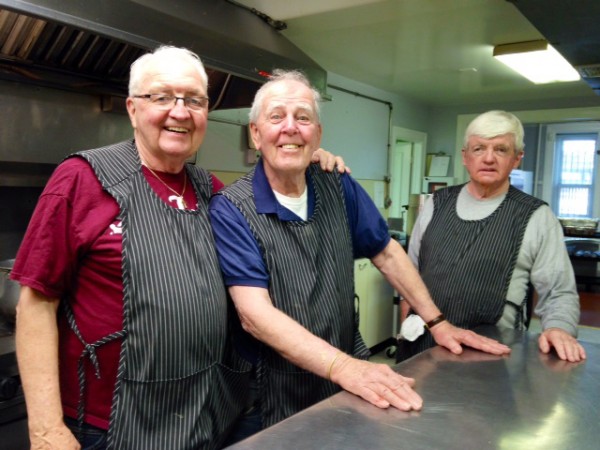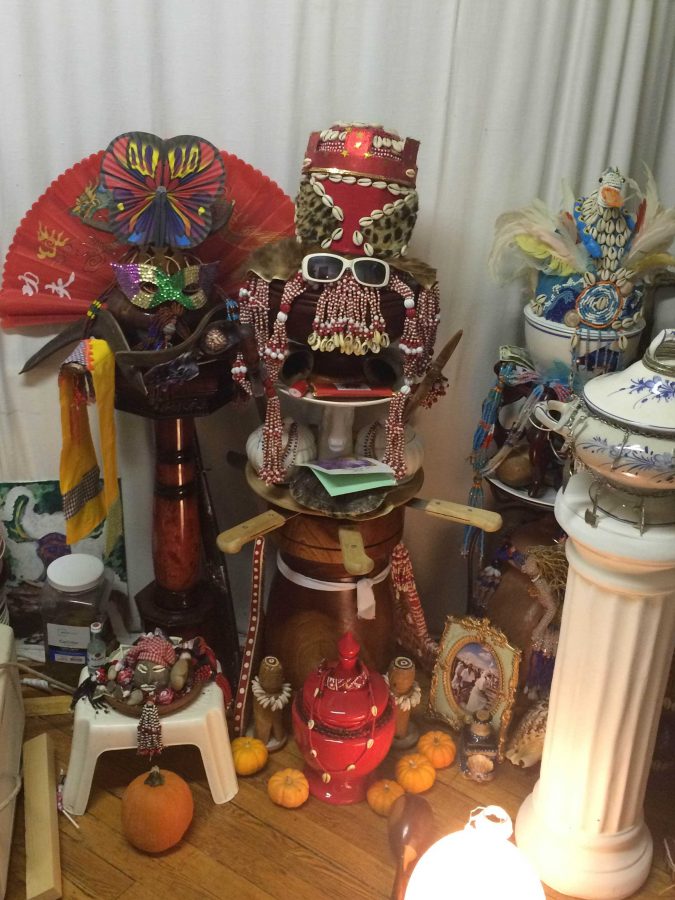By James A. Vezos
Their feet shuffle across the linoleum floor, hands permanently occupied, trading passing glances as they alternate positions. Like on the galley of an old warship, they work behind the scenes with calculated movement.
To the left they chop carrots, onions, and celery for soup. A few feet away, stirrers are seen tasting vats of simmering gravy as serving time approaches. Orders flow down the line. “We need salt.” Then, “More salt!” – Finally, “Here’s the salt.” Typically, this is followed by a gratifying nod of approval.
“Let’s get serious here with these mashed potatoes,” says a man, heartily whisking instant-mash in an oversized metal basin. Not far away, in an ordinary pot, atop one flame of the stove’s eighteen burners, a blend of milk and butter bubbles until it’s ready to be added to the mash.
“It’s a pretty good operation here, isn’t it?”
The aroma of chicken noodle soup, creamy mashed potatoes, and fresh brewed coffee wafts heavily throughout the kitchen. It pierces a foggy veil of solicitude, before exiting through the vents and onto the streets of Newark, New Jersey.
_______________
St. John’s, the oldest Catholic church still in use in New Jersey, and the oldest church in the city of Newark, was organized as a parish in 1826 after holding service in private homes.
The scene above depicts a short clip of what has been taking place since 1974 in the church’s basement. Although it is not the most updated kitchen, the people that operate it consistently serve well over 500 meals a day to “those who have far less than us.”
Two centuries ago Catholics were not very welcome in Newark. But, the building of the Morris canal during the 19th century, and the newly opening factories along the Passaic River brought many Irish immigrants and workers into the area.
The church was completed during 1828 despite many financial setbacks that almost forced the sale of the building. At the last minute the Propagation of the Faith (international association for assistance) in France contributed 22,960 francs to pay the debt.
Under the guidance of Father Patrick Moran, the church was enlarged three times by 1848. Father Moran also had the entire congregation take a pledge of abstinence from alcohol.
_______________
The sound of seagulls cawing can be heard off the West bank of the Passaic River. That is, of course, if the seemingly constant drone of tires zipping across the McCarter Highway seizes for just a few moments.
St. John’s Church is located in a neighborhood in transition in Newark. Bordering what is known as Newark’s old central business district, and the dividing line of Newark’s Ironbound section, St. John’s is located across the highway along the Passaic River, and can easily be considered a borderland community.
Newark emerged in 1860 as the largest industrial-based city in the United States. This area in historical context would be sprawling with factories and tanneries, mainly bordering the river. But now, St. John’s being one of few reminders of this time period in the neighborhood is completely surrounded by the makings of the 20th and 21st centuries.
Across the highway the Claremont Tower houses FBI headquarters. Surrounded by tall black fencing, the perimeter of the building is riddled with security cameras and has a high-tech checkpoint for cars entering the compound. Further down the block men and women carrying briefcases can be seen entering Seton Hall University School of Law. The Prudential Center, home of the New Jersey Devils, can be seen from the opposite corner. Straddling nearly the entire block that St John’s Church was built, a behemoth of music and art, the NJ PAC remains a constant reminder of the present and seemingly never ending transition of this neighborhood.
In the midst of Newark’s recent transformations, 50.4 percent of the total population lives in households with incomes below 200 percent of the Federal Poverty Line. This means half the households in Newark earn less than $47,000 a year for a family of four. More recent data for July 2013 indicates that New Jersey had the seventh highest unemployment rate in the nation.
“This city is trying to re-invent itself,” says Vincent Smith, St. John’s parish manager. “The NJ PAC moved in, Prudential is building a new building on Broad Street, new stores and apartments and things are coming in; what does it actually mean for the poor of Newark? I don’t think a heck of a lot.” The community surrounding St. John’s Church is certainly evolving, but the future and caring of the homeless and working poor is very much uncertain.
_______________

Approaching St. John’s you will notice that the façade is a brown stone of enduring quality, yet severely plain. Ornate details are not attempted, and every line attests utility.
Four graceful pinnacles, whose moldings and shafts are shaped with regard to the eye of the spectator, surmount two towers. The simple indication of use and the entire absence of ornamentation, conform in every way to the chaste simplicity of the structure.
Enclosed behind a black steel fence, a long wooden table lays bare during the early morning. The line leading up to the long wooden table where breakfast and lunch are served wraps around the perimeter of the building alongside the buzzing McCarter Highway. Behind the wooden table a set of concrete stairs leads down into the basement of the rectory and into the soup kitchen where the Tuesday Crew can be found plating food on what they call the line.
Leading the line, Jimmy, a tall baby-faced gentleman with a refined demeanor hands out styrofoam trays to his left and to his right. Buddy, a thick browed man with rosy cheeks slaps a generous portion of mashed potatoes onto the tray. Across from him, John, a grey-haired Paul McCartney look-alike, and also Buddy’s comic relief does the same.
Ray, a retired Deputy Chief of Harrison, New Jersey, tends to the soup behind the line and also doubles as the soup kitchen’s security guard. By no coincidence, far away from Buddy and John, a soft yet well spoken man named Neil loads trays full of food onto a rack. With the same intention as Neil, a man named Jack opens cans of diced fruit for dessert at the other end of the kitchen when he is not collecting money for the NJ lottery.
They have approximately 480 years of life experience among the six of them. Occasionally you can hear something like, “There’s a lot of know-how here, you know that?” Meeting every week to feed the hungry, the Tuesday Crew has made it a habit that has lasted for the past 17 years.
_______________
“I love Newark. I love Brick City, man,” says Sal Turman, a homeless man that throws out trash around the feeding area of St. John’s. “If I was to hit the pick-it right now for a million, boy, I’d build a shelter for the homeless.”
If you go into the Newark Public Library, you will see evidence of people seemingly who are homeless, camping out for no other reason than that they are allowed to. If they are engaging in what one should engage in inside a library, they are left alone. If you go to Penn Station, rows of homeless people are sitting in the waiting area separated but nearby the commuters. They are seldom told to leave.
“There are not many municipalities in Essex County that would allow that,” says Dr. Clement Price, Rutgers Newark history professor, Newark historian, and vice chairman to Obama’s Advisory Council on Historic Preservation. “Newark has the under acknowledged, under-valorized status, maybe stature, of a place where homeless people are not harassed, but allowed to exist and in some cases, as in the case of St. John’s, cared for.”
Along with feeding the hungry, St. John’s provides them with provisions such as deodorant, bar soap, toothpaste, toothbrushes, clothing, and shoes. Six years ago St. John’s was able to start a small medical service that consists of one emergency room doctor and a podiatrist who donate their time. They hold HIV screenings on a regular basis.
The basement of the convent was transformed into a dining area for women and children to eat separately from everyone else. This promotes individual service and one-on-one time with struggling mothers and their children.
“It’s not just giving somebody a meal, if we feel that we can really help, or want to try to help you, of course we will do it,” says Vincent Smith the parish manager. Many times the workers at St. John’s have helped people who are struggling get back on their feet to help them find affordable housing or apartments.
“St. John’s epitomizes the role that Newark has played for well over a generation by being attentive to the people at the distant margins of our society,” says Dr. Price.
_______________
“I started…let me see… it would be the first Tuesday in January, 17 years ago. That was 1997,” says John McGlinchy, a 76-year-old retired electric and gas senior maintenance supervisor from Spring Lake, New Jersey. “I had to question myself as to why I was going… I wanted to do something and wasn’t totally comfortable retiring.”
After growing up in Newark, McGlinchy left in 1956 and moved to Maplewood, New Jersey. He always knew about St. John’s church, but wasn’t aware of their soup kitchen. A friend of his named Jimmy, who still volunteers at St. John’s, told him about the operation around the same time McGlinchy was retiring from PSE&G.
“I keep coming back because I see a very legitimate and caring project,” says McGlinchy. This mentality and willingness to serve his community is not only true for St. John’s church, but seems to run through the very fabric of his life.
Currently, McGlinchy is the vice president of the Historical Society in Spring Lake, New Jersey. In the same town, he devotes time to a mentoring program at H. W. Mountz Elementary School.
A few times he volunteered at McGuire airfield base where he helps cook an American meal for troops coming home from Iraq and Afghanistan. “I got an e-mail here today. I got to look into something about going over there again,” says McGlinchy.
_______________
“American cities are complicated places. They will always challenge the traditional American ethos of homogeneity, harmony, and unbridled progress,” says Dr. Price.
With the city in the midst of a war-related economic boom, Newark’s Submarine Boat Company laid the keel for the first steel ship built in the country in 1917. When the United States rode to prominence as a world power, it did so on the backs of cities like Newark.
Then Newark experienced troubles: deeply entrenched corruption, industrial abandonment, white flight, racial conflict, soaring crime rates, fiscal insolvency, and dire poverty.
“I think we are in a period of transition, and a period in which we don’t know what the immediate and distant future of Newark will look like,” says Dr. Price. “But, certainly it is clear that Newark will survive.”
The future of Newark is beginning to look brighter as it regains its stature as New Jersey’s largest and most important city, while places like St. John’s church, and people as unwavering as its Tuesday Crew, carry it back to prominence.




